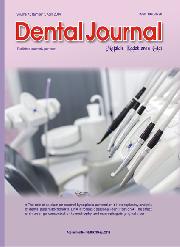Dental Journal (Majalah Kedokteran Gigi)
ISSN 1978-3728
Vol. 47 / No. 1 / Published : 2014-03
Order : 5, and page :25 - 30
Related with : Scholar Yahoo! Bing
Original Article :
Alkaline phosphatase expression during relapse after orthodontic tooth movement
Author :
- Pinandi Sri Pudyani*1
- Widya Asmara*2
- Ika Dewi Ana*3
- Tita Ratya Utari*4
- Department of Orthodontics, Faculty of Dentistry, Universitas Gadjah Mada, Yogyakarta-Indonesia
- Department of Microbiology, Faculty of Veterinary Medicine, Universitas Gadjah Mada, Yogyakarta-Indonesia
- Department of Dental Biomedical Science, Faculty of Veterinary Medicine, Universitas Gadjah Mada, Yogyakarta-Indonesia
- Department of Orthodontics, Faculty of Dentistry, Universitas Gadjah Mada, Yogyakarta-Indonesia
Abstract :
Background: The increasing of osteoblast activities during bone formation will be accompanied with the increasing expression of alkaline phosphatase enzyme (ALP). ALP can be obtained from clear fluid excreted by gingival crevicular fluid (GCF). Bone turnover, especially bone formation process, can be monitored through the expression of ALP secreted by GCF during orthodontic treatment. Thus, retention period is an important period that can be monitored through the level of bone metabolism around teeth. Purpose: This research was aimed to know the relation between distance change caused by tooth relapse and ALP activities in gingival crevicular fluid after orthodontic. Besides that, this research is also aimed to determine ALP as a potential biomarker of bone formation during retention period. Methods: Lower incisors of twenty-five guinea pigs were moved 3 mm to the distally by using open coil spring. Those relapse distance were measured and the gingival crevicular fluid was taken by using paper points to evaluate ALP levels on days 0, 3, 7, 14 and 21 by using a spectrophotometer (405 nm). t-test and ANOVA test were conducted to determine the difference of ALP activities among the time intervals. The correlation regression analysis was conducted to determine the relation of distance change caused by the relapse tooth movement and ALP activities. Results: The greatest relapse movement was occurred on day 3 after open coil spring was removed. There was significant difference of the average of distance decrease among groups A1-A5 (p<0.05). It was also known that ALP level was increased on day 3, but there was no significant difference of the average level of ALP among groups A1-A5 (p>0.05). Finally, based on the results of correlation analysis between the ALP level decreasing and the relapse distance on both right and left of mesial and distal sides, it is known that there was no relation between those two variables (p>0.05). Conclusion: It can be concluded that relapse after orthodontic tooth movement occurs rapidly as the teeth are free from orthodontic force. ALP level can be detected through gingival crevicular fluid during relapse by using a spectrophotometer.
Keyword :
Relapse distance, , alkaline phosphatase, , gingival crevicular fluid,
References :
Krishnan V ,(2009) On a path to unfolding the biological mechanisms of orthodontic tooth movement. - : J Dent Res
Archive Article
| Cover Media | Content |
|---|---|
 Volume : 47 / No. : 1 / Pub. : 2014-03 |
|












